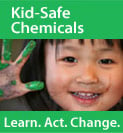Bottled water. Convenient. Costly to our wallet, health and environment. What you should know…
- Estrogen-like chemicals lurk in some bottled water, according to a recent study by the Aquatic Ecotoxicology at the Goethe University in Frankfurt. This endocrine-disrupter could have the same harmful effects as bisphenol A (bpa).
- Chemicals called phthalates, which are known to disrupt testosterone and other hormones, can leach into bottled water over time.
- Bottled water does not necessarily mean safer-to-drink water. Check out the National Resources Defense Council’s Executive Summary on the subject.
- 2.5 million disposable water bottles are thrown out EVERY HOUR… enough to circle the equator every 2.9 days!
- 1500 bottles of water end up in landfill EVERY SECOND!
- It takes 3-5 liters of water to make just one 1-liter bottle, according to the American Recycling Institute. What a waste, especially when youconsider the number of people in the world without access to cleandrinking water! And, 33 billion plastic bottles were purchased in 2007 alone and is forecasted to rise to over 170 billion by 2011. Yipes!
- It takes 17 milllion barrels of fossil fuels to manufacture and transport bottled water (based on 2006 statistics). That’s enough to fuel ONE MILLION cars and light trucks for a year!
- Disposable water bottles take up to 1,000 years to biodegrade, according to the Container Recycling Institute.
- 25% or more of bottled water is really just tap water in a bottle—sometimes further treated, sometimes not (according to the Natural Resources Defense Council). I’ve seen some data suggesting as much as 40% of bottled water is tap water!
- Bottled water gets tested for contaminants only once a week. Tap water is tested for contaminants hundreds of times a month.
- Twenty percent of all bottled water has more chlorine than California’s state regulations will allow in tap water. Chlorine, also known as trihalomethanes, has been linked to cancer.
- The manufacture of every ton of PET produces around 3 tons of carbon dioxide (CO2). Bottling water thus created more than 2.5 million tons of CO2 in 2006. (According to the Pacific Institute).
- Even when recycled, its hard to turn PET into new bottles.
So, you may ask, “what if my water tastes or smells funny” or “how do I know if my own water is safe?” And I will pose the question: Do you remember when bottled water first became popular? When soda started getting a bad rap for being unhealthy. Bottled water became the healthier alternative; and with healthy sounding names like spring water, Aquafina, Evian and Dasani, we became a bit worried about the quality of drinking water that didn’t come in a bottle. Next thing we knew, our refrigerators were stocked with bottled water and we couldn’t go anywhere without it. We became very very thirsty.
But switching back to our old ways–kids drinking from water fountains, drinking water from a glass–is probably not realistic. And, with all of the environmental issues out there (i.e., news about pharmaceuticals in our water), one does have to take pause before pledging to go cold turkey on bottled water and making the switch to reusable water bottles. Bottled water is the safest, right? Not necessarily. But how do I know my water is safe? And what’s a safe reusable water bottle??
My family has been living with well water for 11 years now, filtered only by the refrigerator filter and treated with a softener. Last year our refrigerator filter died and we’ve been drinking 100% unfiltered-straight-form-the-tap water ever since. No, I’m not crazy (and I still feel great). I just decided to start from scratch.
Test the water.
Like everything else, it’s always good to test the water first. How do you know you have a good or bad thing if you haven’t dipped your toe in? We’ve had our water tested by the county almost every year for the last nine with nothing amiss. This year we invested in a more thorough water test kit and everything turned out just fine–and we have well water. No filters necessary.
Movies to watch…
- Tapped trails the path of the bottled water industry and the communities which were the unwitting chips on the table. A powerful portrait of the lives affected by the bottled water industry, this revelatory film features those caught at the intersection of big business and the public’s right to water.
- Blue Gold : Water Wars This documentary follows numerous worldwide examples of people fighting for their basic right to water, from court cases to violent revolutions to U.N. conventions to revised constitutions to local protests at grade schools. As Maude Barlow proclaims, “This is our revolution, this is our war”. A line is crossed as water becomes a commodity. Will we survive?
Filed under: health + safety, water related issues |












[…] potential dangers of BPA has been a topic of my blog and tweets. Worse, warnings against BPA were part of the I Count for myEARTH campaign that I […]
[…] fathom the amount of CO2 released as a result.The potential dangers of BPA has been a topic of my blog and tweets. Worse, warnings against BPA were part of the I Count for myEARTH campaign that I […]
[…] 8 gallons** a day) WITHOUT the plastic bottle waste (SIDE NOTE: the US consumes enough disposable bottled water to–if lined up on their side top to bottom–circle the equator every 2.9 days)! As if […]
[…] recently, I became frustrated with the high rate of bottled water consumption and its impact on the environment–it takes 3-5 liters of water to make one 1-liter bottle of […]
[…] bottled water from your vocabulary — in the US we toss out enough disposable water bottles to circle the […]
[…] what if they leach the hormone-disrupting plastic chemical bpa into our […]
[…] ocean in which so many of these bottles end up, this inspiring documentary trails the path of the bottled water industry and the communities which were the unwitting chips on the table. A powerful portrait of the […]
[…] ocean in which so many of these bottles end up, this inspiring documentary trails the path of the bottled water industry and the communities which were the unwitting chips on the table. A powerful portrait of the […]
[…] consumption of products containing petroleum (including, not limited to, bottled water, plastic, parafin candles, even many lotions and cosmetics contain petroleum based […]
[…] handmade journals. Please dress according to the weather. Shoes are required. Bring your own water (reusable water bottles are the most eco-friendly option) and apply mosquito spray at home. Long pants and long-sleeved […]
[…] are known to disrupt testosterone and other hormones, can leach into bottled water over time. Read more… Thursday, August 5th, 2010 […]
[…] link” between BPA and several diseases, including cancer, and recommended ways to avoid BPA, like storing water in bottles free of it and not microwaving food in plastic containers. Some cancer experts said the report […]
[…] ocean in which so many of these bottles end up, this inspiring documentary trails the path of the bottled water industry and the communities which were the unwitting chips on the table. A powerful portrait of the […]
[…] those “cool” plastic water bottles. I didn’t care that “all the other kids” got to bring bottled water to school. To baseball practice. Or just drink the stuff at […]
[…] those “cool” plastic water bottles. I didn’t care that “all the other kids” got to bring bottled water to school. To baseball practice. Or just drink the stuff at […]
[…] is bpa? Bisphenol A (BPA) is a component of polycarbonate plastics used for food and drink containers. It is also found in resins that line food and beverage cans, thermal paper used to […]
[…] care about the ripple effects of their choices—even the most simple choice, like whether to grab bottled water or take the 2 minutes to fill-up a reusable […]
[…] care about the ripple effects of their choices—even the most simple choice, like whether to grab bottled water or take the 2 minutes to fill-up a reusable […]
[…] but wasteful all the same. And what if they leach the hormone-disrupting plastic chemical bpa into our food? Multiply our take-out by the millions of orders that probably occur in a day, and […]
[…] ocean in which so many of these bottles end up, this inspiring documentary trails the path of the bottled water industry and the communities which were the unwitting chips on the table. A powerful portrait of the […]